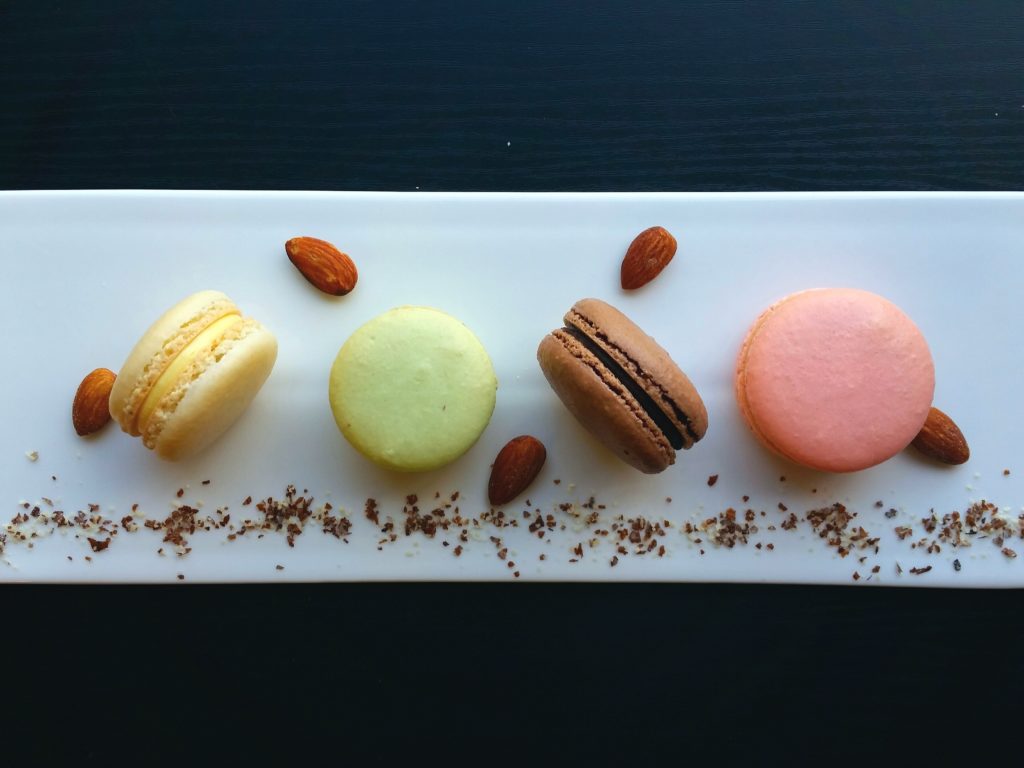 FOUR CLASSIC MACARONS. ALMOND MACARON WITH FRENCH ALMOND BUTTERCREAM. MINT MACARON WITH MINTY WHITE CHOCOLATE GANACHE. CHOCOLATE MACARON WITH NUTELLA DARK CHOCOLATE GANACHE. ROSE MACARON WITH RASPBERRY ROSE MASCARPONE CREAM.
FOUR CLASSIC MACARONS. ALMOND MACARON WITH FRENCH ALMOND BUTTERCREAM. MINT MACARON WITH MINTY WHITE CHOCOLATE GANACHE. CHOCOLATE MACARON WITH NUTELLA DARK CHOCOLATE GANACHE. ROSE MACARON WITH RASPBERRY ROSE MASCARPONE CREAM.
If there’s a dessert with a reputation for its difficulty, it’s the macaron. Bakers will tell you how finicky they are from the temperature and age of your egg whites to the moisture content of your flour and the air. They’ll tell you the recipe for the perfect batch one day might crack, collapse, and end in utter disappointment the next evening. That every measurement needs to be absolutely precise. Yes, there’s some truth to these worries. But no, making consistent batches of macarons isn’t just playing a lottery. Just like perfecting any dish or dessert, macaron making comes down to a few key principles – the meringue, the macaronage, and the drying (notice that the weather, age of your egg whites, and miniscule changes in your flour moisture content are not included!). Whether it’s a hot, sunny day or a cold, rainy day, these principles stay the same. It might take a few batches to know exactly what you’re looking for, but once you get it, you won’t forget it!
- The Meringue. It’s whipped just enough so that you can fold the almond flour and sugar into it completely without knocking out too much air. You’re looking for peaks that gently curl over when the whisk is lifted straight out of it. This gives you the perfect amount of air so that during the macaronage, you don’t deflate the meringue before all the dry ingredients are properly mixed in (underwhipped), and you don’t have a lumpy, broken mixture (overwhipped)! And there’s no need to age your egg whites. It might make whipping them take a minute or two less but makes no difference in the final product. It’s less effort, too.
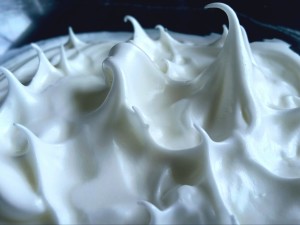
- The Macaronage (or the folding of the solids into the meringue). The macaron batter is a suspension of almond meal in a meringue that has been deflated just enough to pipe out smooth round buttons that spread ever so slightly. This is the part where practice makes perfect. Just keep in mind that it’s better to under-mix than to over-mix, or you’ll have your macarons running into each other on the baking sheet! Some describe this stage as the “molten lava” stage, and others call it the “thick ribbon” stage. Call it what you want, but it should look something like this:
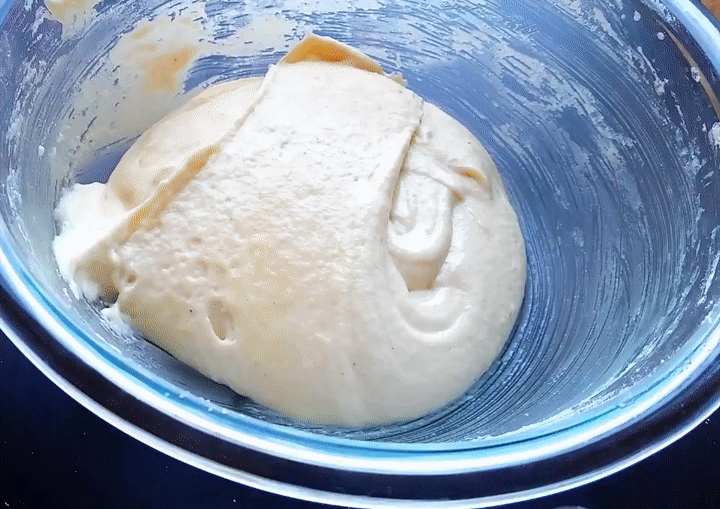
- The Drying. After piping out your cute buttons, you need to set them aside until the tops are dry to the touch and don’t stick to your finger when you “pet” them. Just like with royal icing (the shiny, smooth icing you might find on decorated cookies), a crust forms on the macaron surface as the air pulls moisture from the meringue. This forces the air in the meringue to find another way out during baking – through the bottom, where it bubbles out and forms the frilly feet of the macaron. No need to postpone your macaron-making plans on a rainy or humid day! The drying will still happen – it might just take a little longer.
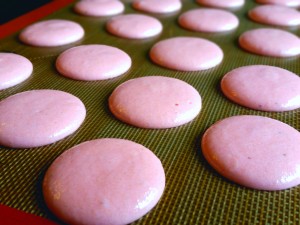
Once you get the hang of it, there are all sorts of small changes you can make to the shell recipe, such as using hazelnut or pistachio flour, or adding extracts for flavor and food coloring for fun. And there is a whole world of fillings to try. Below you’ll find the recipe for the basic almond macaron to get you started, with a French almond buttercream. Enjoy! – Boo and Pea
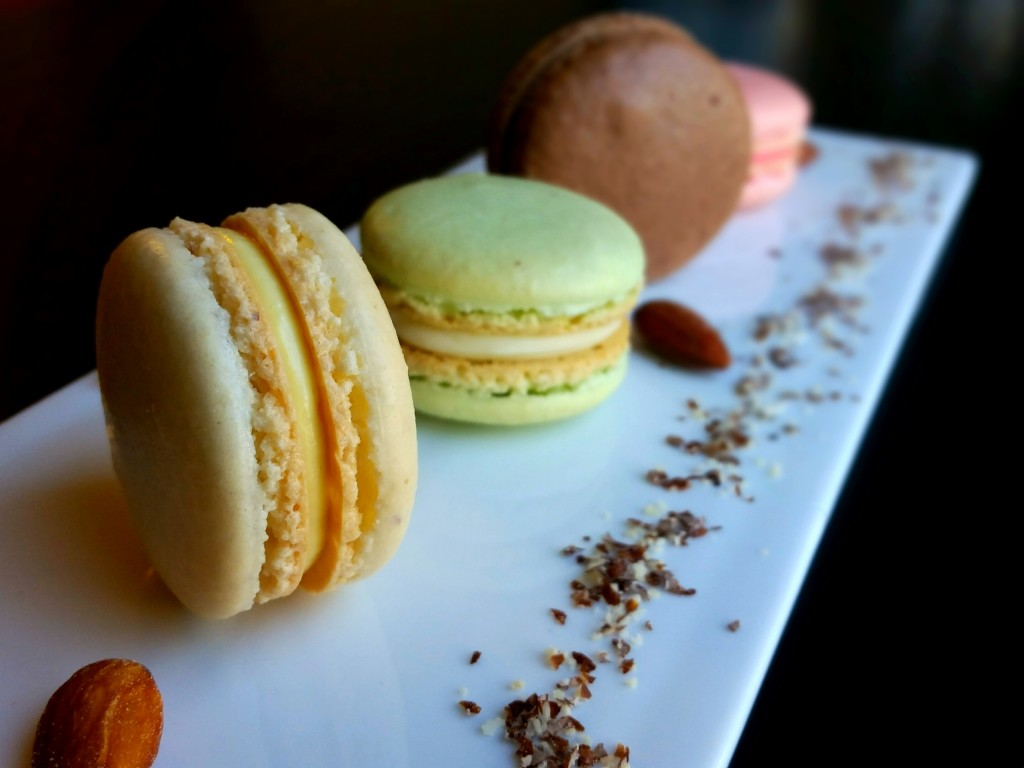 Yield: 44-56 macaron shells
Yield: 44-56 macaron shells
Difficulty: ![]()
Oven: 310 F, 18 minutes
Preparation:
- Line 2-3 baking trays with parchment paper or silicone mats.
- If using parchment paper, optionally draw guide circles (diameter 2.5-3 cm) about 3 cm apart on parchment paper, and flip written-side down.
Macaron shells:
- Dry ingredients, sifted
120 g almond meal
150 g powdered sugar - Meringue
110 g (~3) egg whites, room temperature
0.25 ts cream of tartar (or lemon juice)
100 g granulated sugar - (optional) 4-10 drops food coloring
- In a mixing bowl, beat egg whites with cream of tartar to soft peaks. Gradually add granulated sugar to egg whites while beating to a firm meringue (tips of peaks should gently curl when whisk is lifted), ~4-6 minutes.
- Sift dry ingredients into the meringue. Fold until smooth and falling in thick ribbons.
- Using a large round tip, pipe buttons (diameter 2.5-3 cm) onto the prepared baking trays spaced ~3 cm between the edges of adjacent shells.
Small pea tip: Keep the tip ~0.5 cm above and perpendicular to the baking tray. Keep the tip centered and still while piping each shell to desired size. - Rest at room temperature until surface dries to the touch, 45-60 minutes.
- Bake on middle rack, 18 minutes. Remove from oven, and set side until cooled to room temperature. Meanwhile, make filling.
Small pea tip: Lower the oven temperature by 5-10 F, and bake for 1 minute shorter if using a dark pan. - Carefully remove/peel shells from parchment or silicone mat.
Small pea tip: If macarons stick to parchment or silicone mat, run a thin knife across the bottom to help release shells.
French almond buttercream:
- 3 egg yolks
- Simple syrup
75 g sugar
2.5 tb water - Flavorings
1 ts almond extract
0.25 ts vanilla extract
0.25 ts salt - 6 tb butter, room temperature
- In a mixing bowl, beat egg yolks until light yellow and thickened.
- In a small saucepan, heat sugar with water to 240 F (or just beginning to turn golden).
- Continue beating egg yolks while pouring syrup into yolks a thin stream along the side of the bowl. Beat until cooled to room temperature, 6-8 minutes.
- Beat in flavorings.
- Add butter in 1 tb increments, and beat until smooth and holds peaks.
- Refrigerate for 5 minutes until use.
Assembly:
- Pair shells by size.
- Using a round tip, pipe ~0.5 tb filling onto one shell of each pair. Gently sandwich with second shell.
- In an airtight or covered container, refrigerate macarons in a single layer, at least 8 hours.
- Serve, and optionally refrigerate up to 1 week or freeze up to 3 months.




